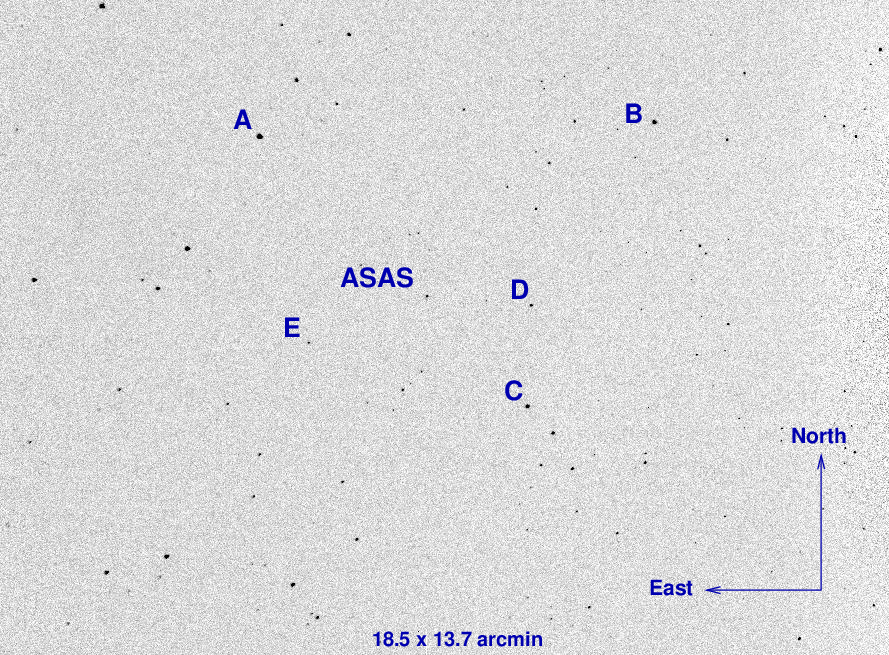
On the night of Jul 31/Aug 01, 2020, under fair conditions, I acquired images of the star ASASSN-20jl. A recent report on VSNET-alert by Denis Denisenko noted that this star had risen by over 2 magnitudes recently, despite its apparently ordinary nature; and Tonny Vanmuster confirmed this on cba-chat.
My measurements show that the star was indeed brighter than normal, in line with the reports, and that it was slowly fading.
You can find some basic information on this star at the ASAS-SN Transients page.
The main setup was:
Notes from the night:
The object is at
RA = 16:46:14.62 Dec = +17:00:17.4 (J2000)
A chart of the field is shown below. The size of the chart is about 19 x 14 arcminutes.

I've marked the location of several comparison stars.
star ID B V ------------------------------------------------------------------------- A BD+17 3086 10.82 10.33 B TYC 1524-1170-1 11.64 10.45 --------------------------------------------------------------------------
I took a photo of the finder TV's screen when pointing to ASASSN-20jl; this could be a useful reference for the future:

I ran the camera at the slightly-higher-than-normal temp of -16 C. Nothing out of the ordinary.

I took a series of 369 exposures of the field, using the V-band filter and an exposure time of 20 seconds. I wasn't able to analyze the images during the run, due to some computer problems, which was unfortunate. The signal-to-noise of the target is considerably lower than I was hoping to acquire, so I could have increased the exposure time to switched to unfiltered images had I known. Oh, well.
The sky value shows that the sky was mostly clear, with just a couple of clouds passing late in the run. The sky value rose as the target set and the Moon rose in the sky.

Here's a record of the telescope's drift. The big jump in Dec is due to a small re-centering I made after a few early observations. Note the drift in Dec becomes pretty rapid later in the night, as the field moves into the western sky. I did not allow Dec corrections in the guider, fearing backlash issues. Maybe I should give them a try next time.

The number of objects detected. It drops at the end of the run due to extinction at higher airmass.

I used an aperture with radius 4.0 pixels tonight.


Using aperture photometry with a radius of 4 pixels (binned 2x2, each pixel is 1.25 arcsec, so a radius of 5.0 arcsec), I measured the instrumental magnitudes of a number of reference stars and the target. Following the procedures outlined by Kent Honeycutt's article on inhomogeneous ensemble photometry, I used all stars available in each image to define a reference frame, and measured each star against this frame.
Sigma-vs-mag plots show that the floor was about 0.015 mag overall, which is not very good. Longer exposures would have helped, as would Moon-less skies.

Here are light curves of the variable and the field stars.

I used the SIMBAD value for the V-band magnitude of star "A" = BD+17 3086 to shift the ensemble magnitudes to the standard V-band scale.
Here's a closeup on the variable. It appears to fade by about 0.1 mag over the 0.15 days of the run.

You can download my measurements below. A copy of the header of the file is shown to explain the format.
# Measurements of ASAS20jl made at RIT Obs, UT 2020 Aug 1, # in fair conditions, # by Michael Richmond, # using Meade 12-inch LX200 and ATIK 11000. # Exposures 20 seconds long, v filter. # Tabulated times are midexposure (FITS header time - half exposure length) # and accurate only to +/- 1 second (??). # 'mag' is a differential magnitude based on ensemble photometry # using a circular aperture of radius 4 pix = 5.0 arcseconds. # which has been shifted so BD+17 3086 has mag=10.33 # which is its V-band magnitude according to SIMBAD. # # UT_day JD HJD mag uncert Aug01.08381 2459062.58381 2459062.58595 12.987 0.026 Aug01.08414 2459062.58414 2459062.58628 13.009 0.027 Aug01.08449 2459062.58449 2459062.58663 12.993 0.026
Last modified 8/01/2020 by MWR.